Ask five people to define jazz, and you’ll receive five different answers. The word is often used as a catch-all to describe a wide variety of musical styles, so a dictionary definition becomes rather difficult to pin down. The first definition on dictionary.com is a whopping 46 words long, if that tells you anything. When asked for a definition of jazz, the great Louis Armstrong responded, “Man, if you gotta ask, you’ll never know.” Duke Ellington said simply, “It’s all music.”
Travis Jackson, ethnomusicologist and professor at the University of Chicago, suggests that jazz is best understood by its processes—“swinging, improvising, group interaction, developing an individual voice and being open to different musical possibilities”—rather than by static musical characteristics.
Stylistically, the music encompasses everything from New Orleans Dixieland to smooth jazz, from big band swing to bebop. Its creative ability to absorb outside influences has led to jazz-rock fusion, Afro-Cuban jazz and Brazilian bossa nova. Jazz can be beautiful and delicate, or abrasive and seemingly devoid of form; it can equally adhere to conventions or break them down. It’s music for your parents and your grandparents—and for the pierced and tattooed kid down the block.
The truth: jazz is a mood, an attitude, a lifestyle, a feeling. It is an endlessly configurable ball of energy, a collection of stories, a malleable mutation of set and setting, of place and person, of emotion and evocation. In an age of bite-sized information, jazz is an art form that cannot be distilled to a sound bite. It moves at its own pace and sometimes requires patience from the listener. It can be appreciated on a surface level or felt as a mystical or spiritual awakening. 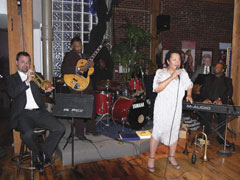
Though it’s been some time since jazz music was commercially popular—Kenny G notwithstanding—over the years it has permeated mainstream culture to a tremendous degree. Jazz music, once the property of shadowy nightclubs and smoky bars, can today be found just about everywhere. Once reviled by the musical elite, it is now, in most quarters at least, accorded the respect it deserves.
The rise of jazz
Jazz is a uniquely American art form, having arisen in the South, specifically New Orleans, in the early years of the 20th century. It was a convergence of African and European musical traditions, filtered through the experience of the African-American community on the long road from slavery to emancipation. The word jazz was first used in the musical sense in about 1915, and, despite a tremendous amount of interest—it was voted the “Word of the Twentieth Century” by the American Dialect Society—its origins remain unclear.
During the Great Migration, more than a million African-Americans headed north to seek a better life and escape the widespread racism of the South, bringing a rich musical and cultural heritage with them. Prohibition arrived in 1920, and with it came “The Jazz Age” and underground speakeasies. Chicago was a hub of activity during this time, with New Orleans musicians like Joe “King” Oliver and Louis Armstrong ruling the city’s nightlife. During the twenties, Jelly Roll Morton toured the Midwest in high style with his band the Red Hot Peppers, averaging $1,500 a night, an astounding figure for the time.
The rise of dance halls, theaters and cabarets in Chicago, New York and elsewhere made for a fertile ground in which jazz evolved and its audience grew. Peoria, of course, was a major stop on the vaudeville circuit, which helped musicians immensely by providing paying gigs.
At this time, under the leadership of Mayor Edward Nelson Woodruff, Peoria was well known for its wild nightlife, earning itself the nickname “Roaring Peoria.” Woodruff’s City Hall openly tolerated such vices as gambling and prostitution, profiting from the “fines” imposed on such establishments. According to historicpeoria.com, “Mayor Woodruff allowed the old city to roar,” and jazz music, being the soundtrack of the times, roared right along with it.
In the thirties and forties, some of the greatest figures in jazz history played right here in Peoria: Count Basie, Duke Ellington, Benny Goodman and Louis Armstrong.
“What happened in Chicago during the Jazz Age, it also happened here,” explained local jazz guitarist Preston Jackson. According to jazz buff Howard Courtney, “Years ago you’d pay 45 or 50 cents to see a movie at the Palace Theater, then you’d see Duke Ellington on the theater’s stage.” In 1940, the Tommy Dorsey Orchestra came through town with drummer Buddy Rich and a young Frank Sinatra in tow. Prior to his solo career, Charles Mingus played Peoria in 1948 as a member of Lionel Hampton’s Orchestra.
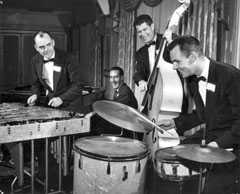 The ghosts of jazz clubs past
The ghosts of jazz clubs past
It would be impossible to condense the history of jazz in Peoria into a short article. That point was driven home when I sat down at Panache one morning with John Philips, a longtime local musician, composer and walking encyclopedia of jazz music. As I took my seat, Philips picked up a pen and began scribbling out a map of downtown Peoria as it looked in the fifties, making special note of the venues for jazz music.
“At this corner [Main & Jefferson, site of the current Janssen Building], there was a building called the Niagara Hotel, and in the basement, they had a place called the Combo Club. And every week or two, they had a different group come in—all kinds of well-known jazz players at the time—and play a two-week stint in the basement. It was a rough-and-tumble place, but you could go in there and have a few drinks, spend a few bucks and hear some big-time jazz players. I worked down there a lot with different local bands.
“Across the street there was a tavern…they always had a piano player,” he continues, pointing at the makeshift map. “Over here was a place called the Fulton Street Steakhouse, and they always had, in my opinion, the best musician I’ve ever known around here—a woman named Sara Murdoch, who played organ and piano together—just absolutely out of this world. So musically correct, so sophisticated and subtle, you just wouldn’t believe it!
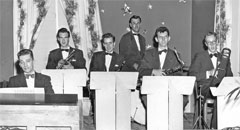 “Next to this was a huge place called the Clover Club,” said Philips. “This place had a circular stage that moved very slowly, and the band played here, and the bar went all the way around it. They could probably seat four or five hundred. It was a big place—marble floors, terrazzo-everything, first-class. And, as with the times, there was a gambling room in the basement—there was gambling everywhere at that time.
“Next to this was a huge place called the Clover Club,” said Philips. “This place had a circular stage that moved very slowly, and the band played here, and the bar went all the way around it. They could probably seat four or five hundred. It was a big place—marble floors, terrazzo-everything, first-class. And, as with the times, there was a gambling room in the basement—there was gambling everywhere at that time.
“Next door was a place called the Preview Club, and they always had at least a piano player—usually a trio—back at the bar. The hotel [Pere Marquette] had a room as you come in from the corner, Rendezvous, and they always had a duo or trio going. In the back, in a big dining room called the Peoria Room, they had a piano player up front, and in the back, they had a six- or seven-piece band,” he explained.
“There was a big ballroom downtown called the Ing Ballroom, and this attracted out-of-town bands, two or three of them a week. The big names—Gene Krupa played there, Woody Herman played there—all kinds of names, they would come to town.” Philips points out the locations of several other former haunts, the names of which have faded with the years.
In those days, there might have been 20 or more bands playing jazz and pop standards in Peoria on any given night. But in the late fifties and early sixties, that came to an end.
“It really dried up in the late fifties. All of a sudden—where did it go?—it was just here yesterday! The hotel quit having the bigger band and went to a weekend policy of…maybe a quartet. They dropped the piano player in the dining room altogether. As you come in, where they used to have the duos and trios, they stopped that,” he recalls.
“The Clover Club was closed in about ’57, ’58—income tax problems with the owner, and he ended up going to prison. The Combo Club went dark in the early sixties. Now you’re down to…the hotel had a piano player on Friday and Saturday night, when there used to be 10 to 12 guys working.” It was the end of an exciting chapter in Peoria history.
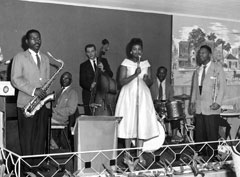 Jamming at the Corner
Jamming at the Corner
Besides the ballrooms, hotels and downtown bars, some of the most exciting jazz in town could be found at clubs which catered primarily to an African-American audience. In those days, racial segregation meant limited opportunities for black musicians. “Peoria was part of the chitlin circuit,” explains Preston Jackson, “which was a route where people of color were able to play.” If a band had gigs in Chicago and St. Louis, Peoria was a natural stop to fill the dates in between.
Drummer/percussionist Cecil Grubbs remembers those days well. “When I first started playing, I was a youngster, about 16,” he recalls. “I played with rock n’ roll groups two nights a week, and I was playing jazz three nights a week. I used to play clubs like Collins Corner and Harold’s Club at that time. Harold’s was on Washington Street, and Collins Corner was around Eaton and Washington, right across from Taft Homes.
“We used to have jam sessions at Collins Corner every Sunday. The attitude with the jam session was: if you couldn’t really play, you got escorted off the bandstand real quick,” laughs Grubbs.
Collins Corner was a notorious club owned by a local businessman named Carbristo “Bris” Collins, who later spent time in federal prison. Though primarily a black club, “quite a few whites used to come” as well, according to Grubbs. It served as a launching pad for the hometown talents of Richard Pryor, who was quickly promoted from opening act to emcee. It was also where the great jazz pianist Jimmy Binkley got his start in Peoria.
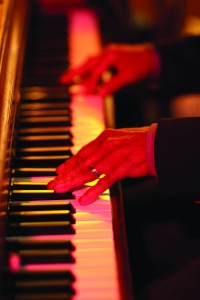 “The biggest heart in Peoria”
“The biggest heart in Peoria”
A Chicago native, Binkley cut a number of records for the legendary Checker, Chance, Dot and Aladdin labels in the fifties and spent much of that decade on the road with his jazz quintet. In 1960, the band was offered a regular gig at Collins Corner, which he called “the swingingest joint in town.” He’s been a fixture in the nightclubs, restaurants and piano bars of Peoria ever since.
Binkley hints at the racial prejudice of the time. “One of the places we worked, we couldn’t sit at the bar,” he remembers. “If someone wanted to buy us a drink, we had to sit in the back room.” When I press him for details, Binkley shrugs good-naturedly, uninterested in rehashing the sins of the past.
“We had black bars, and that’s where you played,” he said. “For you to work at another [white] place, they were taking a chance on you."
After his stint at Collins Corner was up, Binkley landed a gig at the Hunting Room in the Jefferson Hotel. “They brought us in to see how it would work—being a black performer downtown—to see how it would be accepted at the time,” he explained. “And we did so well, such fabulous business, they begged us to come back. But we never knew then how well it would go.”
For a short time, he fronted his own club on Northeast Adams—Jimmy Binkley’s Restaurant and Cocktail Lounge—before finding a home at the Fulton Street Steakhouse in 1970, where he worked for 17 years. By this time, the popularity of jazz was waning, and most of the old clubs had closed down.
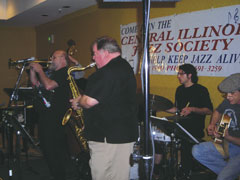 A society is born
A society is born
In 1978, Doug Lady, a jazz fan, musician and then-student at Western Illinois University, came back to Peoria and talked his mother, Jane Lady, into staging a jazz concert in their backyard.
More than 200 people packed the Ladys’ backyard that day. Jimmy Binkley was one of the performers.
“Doug Lady, he thought I was the greatest thing that ever lived,” chuckles Binkley. “He’d come to the [Fulton Street] Steakhouse and look in the window, but he couldn’t come in—he was too young. So I’d go out and get him…and put him over by the side of the bar, sitting by me. Doug Lady, he’s like my son. He’s my friend.”
Out of that evening was born the Central Illinois Jazz Society (CIJS). A nonprofit group open to anyone who enjoys jazz, the Society has sponsored hundreds of jazz shows in the Peoria area since that first backyard gig. In 1979, the CIJS House Band was formed, which remains, to this day, a loose-knit, rotating roster of some of the most respected jazz musicians in town.
Unlocking the secrets
The CIJS House Band plays a significant role mentoring area high school and college students and developing their skills by letting them sit in with the band. The leader of the House Band, saxophonist and Illinois Central College instructor Larry Harms, is a key mentor, helping to “unlock the secrets of jazz improvisation” for many of the area’s aspiring musicians.
“I’ve had some exceptional students who have worked hard and gone on to some really great things,” said Harms. “It’s an enjoyable thing to watch somebody work hard and then, all of a sudden, blossom into a great jazz player.”
Dr. Todd Kelly, director of the jazz program at Bradley University, vouches for the importance of this role. “Mentoring…is how you teach jazz,” he explains. “There are things that you can teach in the classroom—about theory and chord changes and those sorts of things—and we do that, but really, the way jazz has always been learned is on the bandstand.
“What has been most helpful in my teaching has been getting them out there playing a gig,” he reiterates. “Nothing is a better learning experience than that.” To that end, the Bradley Jazz Combo, under Dr. Kelly’s direction, plays a regular gig at Panache every Saturday night.
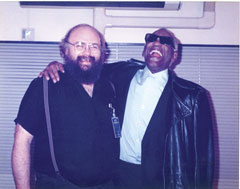 Almost every day of the week
Almost every day of the week
As for the state of Peoria’s jazz scene, it goes through cycles, according to David Hoffman, who plays trumpet and piano in the CIJS House Band, among his many other gigs. “We’re in an up-cycle now, because there are two or three places that are really loyal to it, but you’ll find that places for jazz come and go. If you look back five years ago, for instance, there were different places…but they go, and others take their place.”
“For a town this size, the jazz scene is amazingly strong,” asserts Kelly. “Peoria seems to be in better shape than most areas,” confirms Larry Harms. “When I go to Bloomington or Springfield, they’re amazed at all the jazz that is happening in Peoria. Nobody’s getting rich…but there’s something going on almost every day of the week.”
CIJS President Jane Lady has watched the jazz scene in Peoria evolve over the last three decades. “It used to be that the only time you could hear jazz in Peoria was beginning at ten o’clock at night,” she said. “Of course, now, you can hear jazz four, five, six nights a week, as early as five or six o’clock.”
You just had to be there…
I set out to discover—to define—the history of jazz in Peoria, to “unlock the secrets” of a storied past. But what I discovered was something, like the word itself, too broad to be summed up so neatly—though I tried!
How, really, does one answer the question, “So, what was it like back then?” How do you map that territory for someone who wasn’t there?
Just like the improvisation that is at its heart, the definition of jazz is a moving thing. It doesn’t stay put, and it’s not the same for everyone.
Whether it’s John Philips’ evocation of a long-lost Peoria teeming with jazz clubs, David Hoffman’s 13 years on the road with the Ray Charles Orchestra or Preston Jackson’s memories of sneaking in the back doors of Decatur’s clubs at sixteen, jazz is a collection of people’s stories, of individual moments of experience. To “define” it is to limit it—and leave out an essential piece of the puzzle.
David Hoffman has a knack for boiling the essence of jazz down into words anyone can understand. “The reason people get to like jazz is that there is always a surprise,” he explains. “You can go to a gig, and someone will come in you didn’t expect…the tunes are never the same. Just like Louis Armstrong said: you can’t play anything the same way twice. That is what is most appealing to me, and I think that is what is most appealing for most people, that they can hear the same band every week and still be surprised.” a&s


